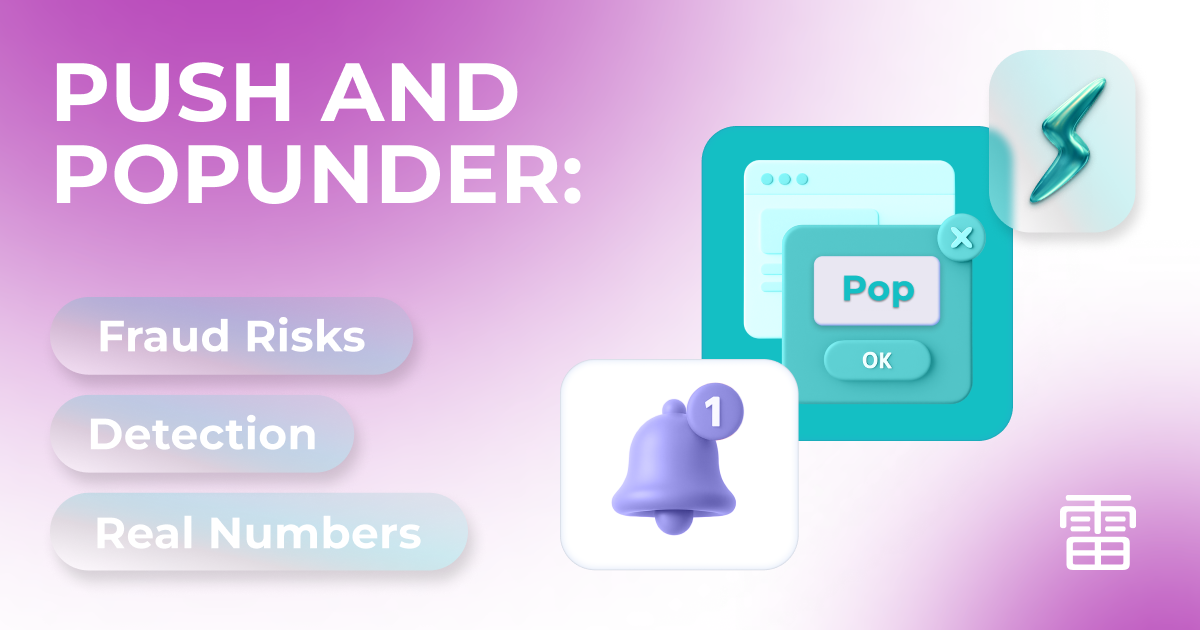Why It Matters
Push notifications and popunder ads remain among the most scalable and affordable formats in performance marketing. Networks value them for their volume and margins. But let’s be honest: fraudsters value them even more.
According to research, 22% of all digital ad spend is lost to fraud. In some verticals, losses reach 30–35%. In push and pop traffic, the risk is even higher — due to their open nature and limited user control.
Kaminari Click processes over 460M clicks per month, and our data shows:
- Push traffic consistently has 25–40% invalid activity, depending on GEO.
- Popunder traffic often exceeds 45% IVT on tier-3 sources.
Push Notifications: Engagement vs. Risk
Push is a powerful tool: in-page and web push deliver 85%+ viewability and instant engagement. But that same high visibility makes them a prime target for fraud.
What we see in Kaminari reports:
- User agent spoofing — bots masking as Chrome/Android.
- Click bursts — thousands of clicks in seconds from a single subnet.
- Malvertising — studies show up to 50% of push ads carry malicious content.
“Push can deliver solid conversions, but fraud quietly eats half the budget. Often advertisers cut spending not because the format doesn’t work, but because no one filtered out the junk in time.”
Popunder: High Scale, High Fraud
Popunder is one of the oldest tools in affiliate marketing. It delivers massive reach: an ad opens in a new window behind the active browser tab.
But its invisibility makes it a fraud hotspot:
- Bot farms generate millions of invisible openings.
- Proxies and VPNs inflate GEO volumes (especially in tier-2/3).
- Invalid conversions: campaigns with tens of thousands of clicks and zero engagement metrics.
Our internal data (Q4 2024):
- Average IVT in popunder = 47% globally, with peaks above 60% in Asia-Pacific.
- Clean tier-1 publishers show much lower risk (~15–20%), but volumes there are limited.
“When a client says: ‘Pop doesn’t convert,’ in 70% of cases it’s not the format — it’s fraud. Once you cut proxies and automation, ROI changes dramatically.”
Detection Best Practices for Ad Networks
Real Numbers — Benchmarks
- Push: 25–40% IVT on average, up to 50% on weaker sources.
- Popunder: 40–60% IVT in high-risk GEOs, ~20% in premium inventory.
- Overall digital: 22–33% of ad spend lost to fraud.
Kaminari Click’s Expertise
Based on audits of more than 200 ad networks, we see:
- The biggest mistake is ignoring fraud until an advertiser complains. By then, the money is already gone.
- The most effective approach is pre-bid filtering: blocking invalid clicks before they’re paid for.
- Flexibility is key: some clients want to filter VPNs, others don’t. With custom IVT settings, you decide what counts as fraud in your reports.
Conclusion
Push and popunder remain the workhorses of affiliate marketing, but that’s exactly why they attract fraud. Data shows 30–50% of this traffic may be invalid without filtering.
For ad networks, the solution isn’t to abandon the formats — it’s to control them.
With real-time detection, flexible IVT rules, and transparent analytics, you protect budgets, retain advertisers, and scale your business.
Kaminari Click reduces fraud in push/pop traffic by up to 60% within the first week of integration.

